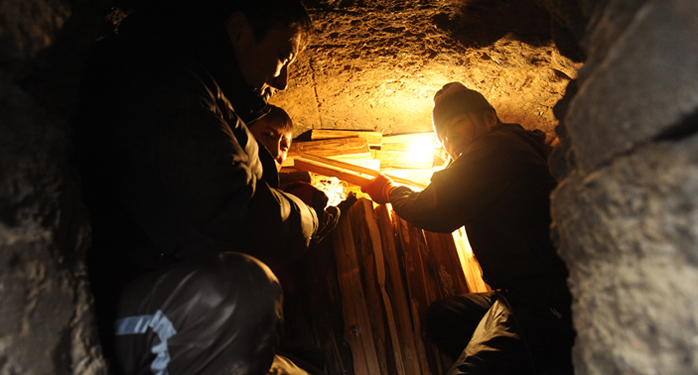
Why Hibino went to Rikuzentakata to make charcoal
Roppongi Art Night’s “Trip→PROJECT” lights the way to new post-3.11 art
A gigantic 8m beacon, shining symbol of Roppongi Art Night 2013, stands in the Roppongi Hills Arena as the main focus for art fans’ peregrinations throughout the city center between art created in museums, parks and shopping areas. One month prior to this year’s opening ceremony, Artistic Director Hibino Katsuhiko traveled to Rikuzentakata in Iwate to make charcoal to light the beacon.
Says Hibino, “I have two big purposes for this Trip → Project. Art Night has been held three times previously, but this is the first time to try connecting the different art displays via a single concept. This time, however, we organized it so that by going around to the various artworks centered on this beacon, the whole city becomes one enormous exhibition. My other aim was to create a memorial bond with Tohoku. Values in art are changing since 3.11. It’s no longer enough to merely please a few intellectuals; we need to find how art can work in society, to establish a new basis for art in our lives. In that sense, 3.11 is a day the art world must never forget.”

The firewood for this year’s beacon is saltwater-damaged cryptomeria from tsunami-hit Rikuzentakata, where the city receives no relief funding for clearing dead trees save for those that pose an immediate threat to houses or roads. Most saltwater-damaged trees still litter the slopes of the disaster area. So in cooperation with the city and local forestry union, Hibino went out in the drifting snow and chainsawed three dead cryptomeria trees, each nearly fifty years old and 25m tall.
“The inspiration came from Ito Toyo’s Home-for-All project. When I heard they were using neglected saltwater-damaged wood for building material, I knew I wanted to use that wood to light a beacon.”
Easier said than done, obtaining clearance to light an open fire in the middle of Roppongi presented a major hurdle.
“Tokyo fire laws stipulate that flames must be kept under 20cm high. We conducted repeated tests, but that’s actually quite difficult. Nor did we want flying ashes to endanger the surrounding community. Whatever, the plan hinged on a Tohoku bonfire lighting up the Roppongi night, so we settled on charcoal.”
The Oide district of Rikuzentakata has longbeen famous for charcoal making. Mr. Kanno Fusao, who opened his own charcoal kiln there after retiring from the forestry union last year, taught Hibino the process. Fifteen workers including Art Night staff labored all day chainsawing logs into 70cm lengths, cutting them down to even pieces by log splitter and axe, stacking the 3m x 2.2m kiln solid floor-toceiling, then finally at nightfall lighting the fire.
“When I explained the project to Deputy Mayor of Rikuzentakata Kubota Takashi, he told me, ‘People in Japan are already forgetting the quake.’ All the more reason to share in physical efforts directly addressing the on-going situation in Tohoku and present that itself as art.”
Hibino’s Roppongi Art Night beacon embodies such a commitment. Deputy Mayor Kubota reports that recovery works are just now beginning in Rikuzentakata and will likely take another five years. Faced with the reality that two years on people are already forgetting 3.11, can we continue to support recovery indefinitely next year and the next? Let the beacon serve as a reminder of the task at hand, a worthwhile focus for art for years to come.
Text: Matsuo Jin Photo: Imazu Satoko